Motto | |||||||
| Anthem: | ""March of the Volunteers" 《义勇军进行曲》 (Pinyin: Yìyǒngjūn Jìnxíngqǔ)" | ||||||
| Capital: | Chengdu | ||||||
| Largest city: | Nanjing | ||||||
| Other cities: | Nanjing, Nanning, Jilin, Xi'an, Beijing (Peking), Shenzhen, Chongqing, Shanghai, Wuhu, Guizhou, Fuzhou, Xining, Jinan, Hohholt, Hefei, Harbin, Dalian, Dandong and Yingkou. | ||||||
| Language: official: |
Mandarin Chinese and Vernacular Chinese | ||||||
| others: | Cantonese Chinese, Hue Chinese, Wu Chinese, Hakka Chinese, Mongolian, Tibetan, | ||||||
| Religion: main: |
Irreligious | ||||||
| others: | Atheist, Buddhism, Taoism, Confucian and Chinese folk religions | ||||||
| Ethnic groups: main: |
Han Chinese | ||||||
| others: | Zhuang, Tai, Kadai, Tibetans, Meaio, Harmong, Koreans, Manchu, Mongols, Uyghur, Kawa and Yao. | ||||||
| Demonym: | Chinese | ||||||
| Type of government: | Semi-presidential authoritarian republic | ||||||
| government: | National People's Congress | ||||||
| C.P.C. General Secretary: | Hua Dongxing | ||||||
| President: | Chen Guofeng | ||||||
| Premier: | Xi Wang Yun | ||||||
| Population: | 975,478,157 | ||||||
| Established: | Pre WW3 | ||||||
| Independence: | from 1962 | ||||||
| Currency: | Renminbi (yuan) (¥) (CNY)/Khabarovsk Rouble | ||||||
| Organizations: | Several bilateral treaties, of a close nature with Khabarovsk and Japan such as the Harbin Treaty and the 1982-1984 Coal for cars Treaty respectively. The Chengdu Pact and the Khabarovsk Pact. | ||||||
| % Literacy: | 97% | ||||||
| Number of military personnel: | 1,227,500 | ||||||
Notice[]
Before editing in the East Asian region, please read China's overview page to fully understand the complex, baffling, bazaar, oddball and weirdo ethnic, political, cultural and religious situation in the former country!
Stats[]
Peoples' Republic of China is the official and most successfully successor to Maoist China. It has also lost some land over the years, most of which is in Tibet, the Autonomous Urgyr region, the Autonomous Inner Mongolia and Yunnan.
National Anthem[]
The Chinese anthem.
- The national anthem of the P.R.C. is- ""March of the Volunteers" 《义勇军进行曲》 (Pinyin: Yìyǒngjūn Jìnxíngqǔ)"
History[]
The Apocalypse of 1962[]
China, Vietnam, Taiwan, Hong Kong, Japan, Thailand and both halves of Korea were hit. Some like Thailand minimal, while both Korea were devastated.
The targets were at-
See- NATO and WP targets in East Asia (1962: The Apocalypse).
After The Apocalypse[]
Both the party-failed Great Leap Forward and the horrific Great Chinese Famine had led China in a calamity, but due to this the NATO nations chose to ignore most of China and only bombed a few major places, rather than going totally homicidal as in the U.S.S.R. Hong Kong was also slightly hit by the U.S.S.R. as a tactical move, which China followed up with a long planned (and wanted) invasion 2 days after WW3, which would see 100,000 flee to neighboring states on makeshift rafts to both Taiwan and South East Asia, as another 6,000 died at the hands of Chines troops in the month long battle to suppress the pro-British/Thai resistance forces. Macau surrendered to China 3 days after WW3. As this happened, thousands of desperate Russians fled in to Manchuria and settled in make-shift camps on the banks of the Mudanjiang River. Some locals and Russians started to set up there own independent states in the Greater Khingan Range and Lesser Khingan Range by 1966. Food shortages, a cholera outbreak and heavy urban riots hit many of the ruined cities and near by refugee camps in the wake of the NATO nuclear attack. The weather became extreme between 1962 and 1965. Many died in the 1964-65 food riots in Taiyuan and Tongliao.
Things became rather chaotic after Mao Xzedong's death became public 5 days after WW3. This had happened as several reformist, ethnic minority, corrupt and/or power hungry party official ran amok in the remoter provinces! With in a week Guangxi province, Yunnan's capital of Kunming, Hongta District (Chinese: 红塔区; Pinyin: Hóngtǎ Qū) is and the county of Yunnyang openly rebelled as state authority began to crumble. Luckly Zhāotōng (Chinese: 昭通) is a prefecture-level city located in the northeast corner of Yunnan province remained loyal and had driven the local rebels out by the May of 1967. With in a month The Xinjiang Uygur Autonomous Region, Nei Mongol Autonomous Region and Tibet Autonomous Regionhad all declaired UDI and had turned on hated local communist party officals on mass. Ordos, Hohhot, Wuhai, Chifeng and Tongliao chose to stay loyal, but Hulunbuir prefecture was a 6 year long general melee between Russian refugees, Mongolians (and local Mongol militias), the Communist Party of China (the CPC) and local Han nationalist militias.
Party loyalists, remaining non-mutinous troops and the more enlightened members of the regional C.P.C. leadership retreated to the recently built, but rather small, strategic bunkers placed the mountains, beside Lake Jingpo, the town of Ürümqi, the city of Chongqing and in a few tactically important places among the Mudanjiang River, the upper reaches of Yellow River, the Fen River 汾河 and the Wei River 渭河.
Most mountain bunkers were concentrated in thes locations-
- Longmen Mountains
- Hengduan Mountains
- Xuefeng Mountains
- Huangshan
- Lesser Khingan
- Zhongtiao Mountains
- Tian Shan
- Jiuling Mountains
- Min Mountain Range
The nuclear winter and summer caused much hardship with heavy snows falls, lasting for several months, as far south as Shanghai at one point. A usually large and moist Pacific typhoon the hit Taiwan and the provinces of Shanghai, Zhejiang and Fujian. The heavly fortified Lazikou Pass in the Min Mountain Range would serve as a make-shift headquarters until the interim Gansu divisional C.P.C. leader, Wang Deng Chen, moved it to the city of Chengdu was secured from local insurgents in the December of 1965. The rebels were loyal to the regrade local prefecture leadership.
The county-level city of Wǔzhǐshān (Chinese: 五指山) in the south-central part of Hainan Island had also go rogue at about the same time in the June of 1964, but held out successfully against the forces of the C.P.C. and the pro-C.P.C. Hǎikǒu-Wénchāng Republic was formed out of the loyal Hǎikǒu Shì 海口市 county level city and the loyal Wénchāng Shì 文昌市 county. Most of the south of the Island had formed a loose anti-Chinese confederacy, which would dump China in the September of 1964 and joined up with the Philippines in the March of 1976.
Riots had occurred some towns and villages of the Ngawa Tibetan and Qiang Autonomous Prefecture in the March of 1964 and the May of 1965.
Overall 200,105,606 Chinese, 6,500 Hong Kongers, 45 Macauiese and 145,000 Taiwanese died in the 3 years directly after World War 3!
The '1st Time of Chaos'[]
Riots had occurred some towns and villages of the Ngawa Tibetan and Qiang Autonomous Prefecture in the March of 1964 and the May of 1965. Wang Deng Chen was elected the interim national C.P.C. leader 12th June at a special C.P.C. summit in Chongqing. A political unclaimed bomb composed of 600 pounds of amatol, 225 pounds of dynamite, and 475 pounds of tar exploded in a neighboring part of Chongqing, killing 60 people and a further 200. Chairman Wang Deng Chen was also slightly injered in the attack.
Chinese government forces would be driven out of the towns of Ürümqi, Kunming and Lhasa in the December of 1965. Hainan Island would become an independent on January 1st 1965. Golmud City in Haixi Mongol and Tibetan Autonomous Prefecture and Yushu Tibetan Autonomous Prefecture on January the 8th. A day later the rest of the Prefecture was over run by local malcontents and anti-Communists, who created the pro-Western Haixi Mongol and Tibetan Democratic Republic. As the troubled province's chaos spread local monks set up a benevolent monastic sate in the sparsely populated Golog Tibetan Autonomous Prefecture on June the 4th. They soon became respected for there neutrality, humanity and the fact they genuinely welcomed every one (even the CPC) as friends, which helped secure the states' long turn survival.
Yunnan province, Ngawa Tibetan and Qiang Autonomous Prefecture and Chengdu City all declared there independence from the People's Republic of China in the January of 1966, but it would be another 4 years before it would be secured. A few days later the C.P.C. forces were ejected from Chengdu by local rebels, but the C.P.C. forces retook Chengdu from the renegade prefecture leaders after a hard battle in the May of 1966. The rebel leaders were then summarily executed.
The government held part of Qinghai (Chinese: 崇左;) was fully stabilised in the Summer of 1967 and Guangzhou by the autumn of 1967. Luckly Zhāotōng (Chinese: 昭通) is a prefecture-level city located in the northeast corner of Yunnan province remained loyal and had driven the local rebels out by the May of 1967. Szechuan was fully under government control by the summer of 1968.
The Chóngzuǒ (Zhuang: Cungzcoj) prefecture-level city in China's Guangxi Zhuang Autonomous Region saw a rebellion by the Zhuang population against Chinese rule in mid 1967, which would spread to most of Yunnan by late 1968.
As the years passed the Chinese government forces began established the country and brought most of it back under there control. Many of the excesses of the old regime were also moderated by the Autumn of 1969.
1969-1973[]

Benxi city center in 2012.
After the pandemonium caused by the events following destruction of Mao, the party elite, several ports and many of the nations industrial zones; the country began to settle down and the rebellious party officials were mostly crushed and liquidated by rather dubious local appointed pro-C.P.C "people loyalty courts"! Such acts of dis-honer by party members would never be let get so out-of-had ever again! Prisoners and prisoners of war would be regularly worked to death as slave labour until it was banned in 1998.
The heavy irradiated and nationalistic Manchu Republic declared it's UDI on July 7th 1971 after a major famine and cholera outbreak hit Xinbin, Benxi and near by Donggang. It consisted of Autonomous Manchu Counties of Benxi, Huánrén, Xinbin, Qingyuan and Kuandian.
Henan province was the last to be passivated in the March of 1971, but the suppression of Tibetan rebels in Sichuan would continue in to the summer of 1972. Most of the country would be reunified by late 1972.
The repaired Benxihu Colliery reopened on August 1st, 1973.
~~(more to come)~~
The Journeys of Discovery[]
Chinese exsplores had made contact with the Urals SSR and Yakutia in 1978.
Fist Contact[]
This was with Japan, Mongolia and boat halves of the ruined Vietnam in 1972, Laos in 1973, the Republic of Khabarovsk and the Amur Basin in 1974 and Taiwan in 1975. Japanese ultra nationalists and imperialists rebelled at this time, but like the separatists in China and ultra nationalists in Taiwan, they would fade, except in a few places like Yunnan and Tibet.
1975-1979[]
Bamboo and farm tools were given by China to N. Vietnam in 1975 and 1976. N. Vietnam conquered the south with limited Chinese and Cambodian help in in 1978.
The harvests would gradually increase after 1977 and become substantially improved by 1980. The limited mechanization of China's rice cultivation took place between 1977 and 1979. The Szechuan party official and party economic reformist Deng Xiaoping became the joint finance and trade minister in 1979.
~~(more to come)~~
The 'May 1st, 1980, Chengdu Incident'[]
The 'May 1st, 1980, Chengdu Incident' was a popular pay and working conditions demonstration in the city's central industrial zone, committed by stone, metallurgists and furniture workers, that was crushed by China's army May 1st, 1980. 130 protesters, 6 policemen and a soldier died in the incident. A few less well attended coppycat riots were quickly quashed in Hong Kong, Shanghai, Xi'an, Bejing and Macau.
The '2nd Time of Chaos'[]
The Korean region in Manchuria had it's Korean and Manchu minority break away from China to form The Peoples' Republic of Korea the in the March of 1981. Food and anti-government riots hit Muckden for most of the Autumn. The Yanbian Korean Autonomous Prefecture formed the coral territory.
Poogin Nodongjagu , Poogin Workers' District, Poogin Coal Mine were cleared of all people due to toxic fallout and extreme damage in the war, it became habitable in 2008. The Manchurian based The Peoples' Republic of Korea (China’s long standing Korean ethnic minority) layed claimed to it in 1982 and it was explored by China in 1972 and the PRK in 1988. Legally the PRK own the former Korean land and China has let them take it over.
The othere two rebelions were in the far south, during the june of 1982. Hechi (Zhuang: Hozciz; Chinese: 河池; pinyin: Héchí; literally "river pool") is a prefecture-level city saw an ethnic rebellion by the majority Zhuang people, which lead to the formation of the Hechi SSR. A less than loyal Běihǎi (Chinese Postal Map Romanisation: Pakhoi; Chinese: 北海) prefecture-level city branch of the CPC declared the more religiously and Vietnam/Philippines orientated Běihǎi Republic.
1982-1994[]
Sino-Japanese relations began to thaw after the 1982-1984 coal for cars treaty was singed. The now fuel-less Japan would give abandoned and unwanted cars to technologically backward China in exstange for coal imports. The coal was mined by convicts, subversives, disodents and other 'disruptive' and 'hooligan' elements of society. The long term reconstruction of the ruined cites began and several special enterprise zones opened in 1984.
The zones were at-
- Foshan National New & Hi-Tech Industrial Development Zone
- Shantou Free Trade Zone
- Shatoujiao Free Trade Zone
- Zhongshan Torch High-tech Industrial Development Zone
- Shenzhen Hi-Tech Industrial Park
- Yantian Port Free Trade Zone
- Shenzhen Export Processing Zone
- Zhuhai National Hi-Tech Industrial Development Zone
- Chengdu National Hi-Tech Industrial Development Zone
- Chengdu National Metalergical Industrial Development Zone
- Beiging National Hi-Tech Industrial Development Zone
- Shanghai Port Free Trade Zone
- Kowloon Port Free Trade Zone
- Kowloon National Hi-Tech Industrial Development Zone
- Dongying National oil Industrial Development Zone
- The North Zhejiang National Agricultural Development Zone
All rice cultivation is highly labour intensive and weather-prone. The limited mechanization of China's rice cultivation only minimally advanced output. Rice cultivation also demand more fertilizer and good weather, than most other crops.
Economic ties with Japan, Mongolia, Vietnam and Taiwan were improved during the late 1980's and trade began to pick up in the early 1990's, leading to increased property for all. Japan and Taiwan had laid idle due to lack of resources ad China lacked technology and education, so they pooled resources and advanced as a single trade block called The Chegdu Pact of 1992, with Khabarovsk joining in 1993. The treaty became largely obsolete when those nations helped in creation of the economic and monitory union called the Khabarovsk Pact in 1997.
Deng Xiaoping retired as finance and trade minister in 1994 and died in 1998 of natural causes. He is seen as a messianic figure in China to this day!
Many private corporations jointly with the state-owned mining corporations had invested billions of Renminbi in the coal and bauxite mining Industry of Shanxi Province in the early 1990's.
Bajing's Xicheng District was rebiult between 1994 and 2004.
~~(more to come)~
The reforming of Communism[]
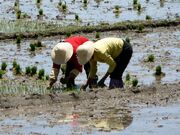
New enterprises were started with rice, coal, clocks and clothing taking high priority under the Sino-Japanese trade pact of 2001.
China had noted the changes in Khabarovsk and chose to start it's own reforms. The communist system would be wound down between 1995 and 1997, but politics would still be fairly left wing. China finally become a authoritarian socialist state in 2002. Relations also began to improve with Tibet and Yunnan.
The Heihe race riots of 1996-7,in which 20 Chines and 16 Russians had died, sowed the need to resolve the Sino-Russian racist problem in the Republic of Khabarovsk and the Amur Basin. China and Mongolia were very concerned by the event.
The Déhóng Dǎizú Jǐngpōzú Zìzhìzhōu 德宏傣族景颇>族 自治州 county peacefully split from the Yunnan Republic on ethnic and cultural grounds to form the Jingpo Democratic Republic on May 1st, 1999. The Chinese authorities were quick to offer trading relations to boath as a way of increasing rice and stone resources. Both nations agreed to a customs union with China, as did the much reduced coastal Hǎikǒu-Wénchāng Republic.
The close and binding Harbin treaty of May 12th, 1999, was singed with Republic of Khabarovsk and the Amur Basin on issues of stone trade, coal trade, iron ore smelting and logging permits. Both economies have developed greatly since.
Relations grew closer between the PRC and the Golog Tibetan Monastic Prefecture , Liangshan Yi Prefecture, Manchu Republic, Hǎikǒu-Wénchāng Republic, |Jingpo Democratic Republic and Vietnam between 2000 and 2002 that they set up a joint disaster releaf and cultural exstange treaty between each other on May 1st 2002.
~~(more to come)~
2003-2007[]

The design of cloths became more fashionable after 2004.
Shandong was found to have major gold and diamond fields in 2003. Japanese, Chines and Thai mining corporations have worked them since 2004. Most of the industrial grade diamonds are exported to Japan.
The Chinese eonamy grew by an average of 7% and the Japanese econamy grew by an average of 6.5% per annum between 2003 and 2007.
Cloths became more fashionable after 2004.
~~(more to come)~~
2007 Chengdu paint factory explosion[]
Also see- The economy and natural resources of China (the P.R.C.)
Present day[]
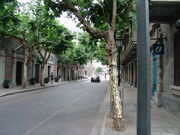
A Shanghai street in 2010.
Relations with Vietnam, Mongolia, Singapore, Khabarovsk, Kamchatka, Thailand, Japan, Palau, Cambodia, Bhutan and the Philippines have flourished since 2005 and China became a major exporter of coal in 2008.
A monument was erected in the the reconstructed Xicheng District (simplified Chinese: 西城区; traditional Chinese: 西城區; pinyin: Xīchéng Qū, lit. "West City District") district nofi Beijing, in honour of all the dead from WW3. ~~(more to come)~~
2008 Sichuan earthquake[]
The 2008 Sichuan earthquake or the Great Sichuan Earthquake or Wenchuan earthquake (Chinese: 汶川大地震; pinyin: Wènchuān dà dìzhèn) of Monday, May 12, 2008, was
~~(more to come)~~
2008 Canton cyclone[]

Floods in Shcizeng.
A major cyclone hit Canton between the 1st and 3rd of August, 2007, killing 16 people. It burnt out over Hainan 4 days later. It had first occurred over Palau a week earlier and had killed 1 person as it passed over the city of Manila 2 days earlier.
~~(more to come)~~
Politics[]

A loyal, obedient and righteous C.P.C member from Fujian enjoys extra privileges in her motherhood.
The politics of China is structured in to a left wing/social democratic, de-facto single party-government system. This applies equally to the parliament and the presidency, as is also dose all the other lesser governing institutions in the P.R.C. The C.P.C. dose not tolerate any descent and very little criticism beyond economic, ethnic and environmental issues! The nation is a de-facto one party state with only a few small and invective (outside of green, economic and ethnic issues) superstition parties. Jenny Chu is the national political commissioner for electoral fairness in China.
Nancy Chang is the leading opposition figure and is the leader of the Green Party. Lynda Yeuh is leader of the Taiwan Democratic Self-Government League.
Relations are poor with the rebel nations Chóngzuǒ County (1962: The Apocalypse) and Wǔzhǐshān County (1962: The Apocalypse), but are good with Japan, the Hǎikǒu-Wénchāng Republic, Khabarovsk, Thailand, Vietnam and the Philippines.
2012 parliamentary election results[]

2012 electoral result.
- Communist party of China, 612,
- China Democratic League, 54,
- China Association for Promoting Democracy, 53,
- China Democratic National Construction Association, 52,
- Revolutionary Committee of the Kuomintang, 44,
- China Zhi Gong Party, 38,
- Chinese Peasants' and Workers' Democratic Party, 30,
- Green Party, 25,
- Independent, 22,
- Taiwan Democratic Self-Government League, 20,
- Tibetan ethic party, 15,
- Tai-Lao ethnic party , 15,
- Jiusan Society, 10,
- Anti-Corruption, 10.
Military[]
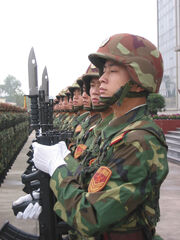
The PLA on parade outside the national army collage in 2009.
It has a conscript force of 900,000 and a volenteer force of 327,500. There is also a 25 strong P.R.C. Chinese garrison in Koror.
Army[]
Weapons[]
Air force[]
Aircraft and Weapons[]
[]
Ships and Weapons[]
It has 2 armed ice breakers, 12 joint minesweeper/layers, 8 corvettes, 5 Frigates, 4 hospital ships, 4 stores ships, 4 vittlers (food ships), 6 fleet oilers, 4 collier ships, 4 ammunition ships, 4 troop ships 4 destroyers, 3 cruisers and 30 patrol boats.
Economy[]
Overview[]
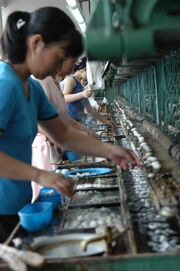
Silk is a major industry in China.
Deng Xiaoping's enlightened open door policy radically changed the economy of the province as it was able to take advantage of its access to the ocean, proximity to the Philippines, and historical links to overseas Chinese in East Asia and South east. Much Japanese and Khabarovsk investment has occurred. Some Thai, Vietnamese and Filipino firms are also active in the country. Rice, coal, iron, oil, copper, sorghum, bamboo, salt, beer, silk, vehicles, machinery and lots more are produced in the nation.
China is considered to have a highly stable economy, with one of the lowest unemployment rates in the Orient, no meaningful national debt and a reasonable budget surplus.
Also see- The economy and natural resources of China (the P.R.C.)
Corruption[]
In 2005, Palau passed its first bank regulation and anti-money laundering laws after the Deng Xiaoping Finance Building money laundering affair with China.
Trade partners[]
Trade is mainly with Kingdom of Thailand, Golog Tibetan Monastic Prefecture (1962: The Apocalypse), Liangshan Yi Prefecture (1962: The Apocalypse), Manchu Republic (1962: The Apocalypse), Hǎikǒu-Wénchāng Republic, Jingpo Democratic Republic, Vietnam, The Philippines, Kingdom of Laos, Kingdom of Cambodia, Uyghuristan, Kamchatka-Kuril SSR, Republic of Khabarovsk and the Amur Basin, Mongolian Republic, Empire of Japan (1962: The Apocalypse), Palau, Ireland, Tajikistan and The Peoples' Republic of Korea (1962: The Apocalypse).
There are limited relations with Kingdom of Bhutan, Nepal, India, Bangladesh, Kashmir, Democratic Republic of North Afghanistan, Tibet (1962: The Apocalypse) and Taiwan (the R.O.C.) (1962: The Apocalypse).
New relations have been formed with Khalistan (1962: The Apocalypse), The Kingdom Bahawalpur (1962: The Apocalypse), Kingdom of Hyderabad (1962: The Apocalypse) and Kuwait (1962: The Apocalypse).
Transport[]

A woman on a tram in 2009.
The Shanghai tram network was created in 2007 and had 16 stops on 3 lines. Bajing and Xi'an have some to. Many trains link most medium and all big citys, but rual servaces are still poor and infrequent.
~~(more to come)~~
Education[]
It is mandatory for all children between the ages of 4 and 18, but some rural children only do 5 to 16 due to local issues concerning the use of juvenile farm labour. Chengdu and Harbin universities are major intellectual nodes in Asia.
Pandas[]

A giant panda photographed in Sichuan.
Sichuan set up several giant panda reserves between 1977 and 1997.
Media[]
Leading newspapers[]
- The Xinhua press agency was started in November 1931 as the Red China News Agency and changed to its current name in 1937. Xinhua Daily (Chinese: 新华日报; Pinyin: Xīnhuá Rìbào) was the first public newspaper published in the People's Republic of China by the Communist Party of China and is owned by Jiangsu's Committee of the Communist Party of China.
- Guangzhou Ribao (Chinese: 广州日报; Pinyin: Guǎngzhōu Rìbào) is the daily newspaper official newspaper of the Guangzhou municipal party committee. It is published by the Guangzhou Daily Newspaper Group and was established on December 1, 1952.
- Science and Technology Daily (科技日报, Keji Ribao) is the official newspaper of the Ministry of Science and Technology of the People's Republic of China.
- The China Securities Journal (simplified Chinese: 中国证券报; traditional Chinese: 中國証券報; pinyin: Zhōngguó Zhèngquàn Bào) is a national ecanomic securities newspaper. It is sponsored by the Xinhua News Agency. It is one of the most important publications in the financial field and was fouynded in 1992.
- Macao Daily News (simplified Chinese: 澳门日报; traditional Chinese: 澳門日報; pinyin: Aòmén Rìbào) is (as of 2005) the bestselling newspaper in Macau.
- Headline Daily (Chinese: 頭條日報 Pinyin: Tóu Tiáo Rì Bào) was launched on July 12, 2005 by Sing Tao Newspaper Group Limited and became the free Chinese newspaper published officially in Hong Kong.
- Sichuan Daily (Simplified:四川日报; Pinyin:Sìchuān Rìbào) is a leading Chinese language daily newspaper based in Chengdu, Sichuan, mainland China with a circulation of 7, 500,000 as of 2012.
- The Legal Daily (Chinese: 法制日报; pinyin: fǎzhì rìbào) is a People's Republic of China state-owned newspaper under the supervision of the PRC Ministry of Justice that is published in the PRC and primarily covers legal developments.
- PLA Daily (Chinese: 解放军报; Pinyin: Jiěfàngjūn Bào) is China-based media outlet for the People's Liberation Army (PLA) of the People's Republic of China.
- The Chengdu Economic Update is a economic daily and has been in cerculaion since 2003.
- The Shanghai Economic Update is a economic daily and has been in cerculaion since 2004.
- The Beijing Economic Update is a economic daily and has been in cerculaion since 2004.
- The Chongqing Economic Update is a economic daily and has been in cerculaion since 2004.
- The Xi’an Economic Update is a economic daily and has been in cerculaion since 2005.
- The Shenzhen Economic Update is a economic daily and has been in cerculaion since 2005.
Radio[]
Xinhua New Chinese Radio (XNCR) went on the air from Yanan on December 30, 1940, with a trasmitter donated by Rado Moscow! It operated on 3 AM and 1 SW frequecy since 1985.
China Radio International (CRI), (Chinese: 中国国际广播电台; pinyin: Zhōngguó Guójì Guǎngbō Diàntái) the former Radio Beijing and originally Radio Peking and was founded on December 3rd, 1941 It is the state-owned international radio station in the People's Republic of China (PRC). Broadcasts stopped in the post-disaster period of 1962-72.
China Radio International broadcasts to South East Asia, East Asia, Palau, Guam, the Northern Mariners and Siberia, on 4 AM frequencies and to Khabarovsk on 3 FM frequencies since 1987.
Most towns have a Chinese language FM station, but some also broadcast in Tibetan, Mongolian, Zhuang and Japanese since 1997. Hong Kong and Macau also have there own FM stations to.
Urban TV[]

A interview in Chengdu with happy workers by CCTV.
Press cencorship.[]
The C.P.C. dose not tolerate any descent and very little criticism beyond economic and environmental issues!
Healthcare[]

Hats are still commonplace in some conuties due to continued radiological baldness.
Lung, thyroid and skin cancer ceased being a major issue in most of China after 1967.
Radiation coming from Korea would kill many and cause much ill health in Manchuria until 1987.
Sports[]

The Chinese hockey team celibate there crushing 7-2 victory over Cambodia in the 2012 East Asia Games.
Football, badminton, field hockey, table tennis, mahjong and chess are the national sports.
China, Japan, Cambodia, Khabarovsk and Yunnan stared the East Asia Games off in 1994. It is held every 4 years.
The Chinese field hockey team celibated a crushing 7-2 victory over Cambodia in the field hockey finals of the 2012 East Asia Games.
Law, order and the death penalty[]
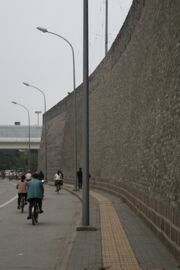
Outside the perimeter wall of Chengdu's central prison.
Public humiliation, hard labour and 'political/social reduction' are the main methods of punishment in the P.R.C.
Military deserters, Murderers, sex predators, (rapists and child molesters, ect), traitors, epople who try to damage the C.P.C. (Communist Party of China) and enemy spies are executed by a firing squad.
The recreational use of hard narcotics is banned on pain of death. Soft drug use is punishable with as harsh fine, public humiliation and intensive 're-education'.
Some recent cases[]
- As a result of smoking opium, 3 were fined 6,000 Rumbani and forced to squat facing the market stall for 12 hours with out rest. Those who's trousers could be made show bum-cleaveage were made to do so for added discomfort and humiliation. They were made undergo 2 months intensive 're-education' afterwards.
- 2 'anti-communist' Zhuang women were tied to a post for 2 days in Chengdu as a way to publicly humiliate them. They were made undergo 3 months intensive 're-education' afterwards.
- A disruptive, uncooperative and rebellious former C.P.C. member from Jillin, was removed from the party, dehoused and forced to work as a impoverished street-vender after is was discovered that she was stealing money from the local supermarket she was working at. Later, she was given 6 months intensive 're-education', but it could not 'reform' her and so she stayed as a pesent vendor as punishment.






